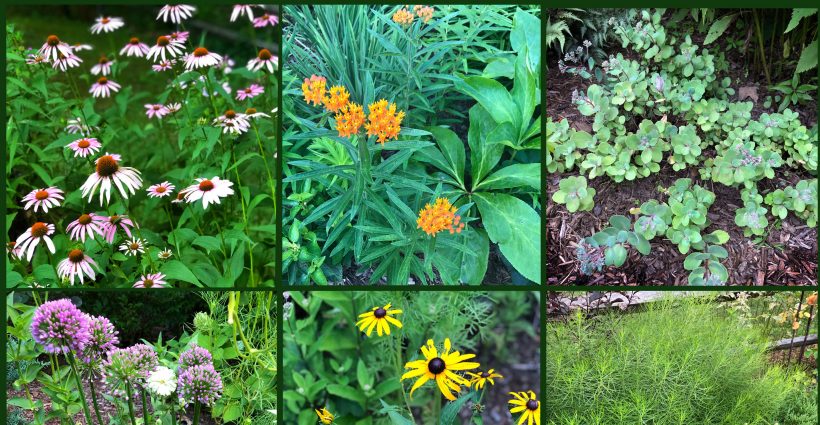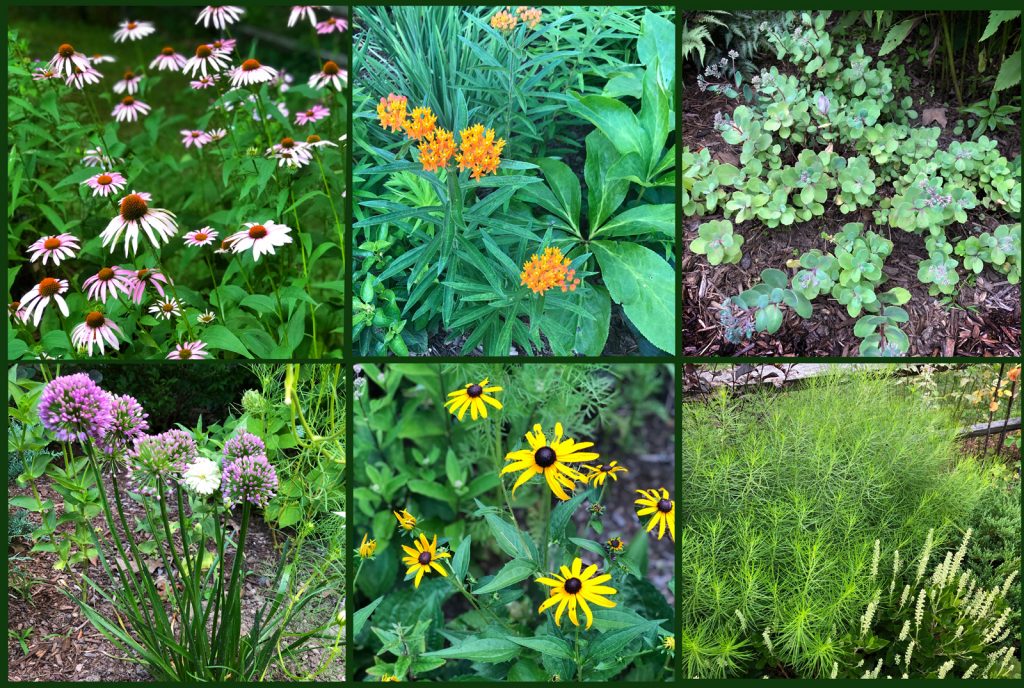designed for the way women work.

Heat and Drought Tolerant Perennials For Your Garden
Category: Presenting "The Curious Gardener"
It’s time to publish Ruth Clausen’s list of heat and drought tolerant perennials. The heat came early this year and it is taking its toll on some plants. Over the years I have been planting many of the perennials on her list, with the goal of creating a water-wise garden!
By drought tolerant we mean they can withstand dry conditions for a few days and will recover from drooping during the day. It doesn’t mean they should stay dry for several days. Drought resistant plants, by contrast, can stay dry for longer periods of time and are well adapted to an arid climate (cactus for example). Heat tolerant plants can withstand direct sun and high temperatures. They don’t ‘meltdown’ to use Ruth’s words.
In the image shown at the bottom of this post are 6 perennials growing in my garden. On the top row, from left to right are: Purple coneflower, Butterfly weed, Stonecrop; and on the bottom row left to right are: Allium, Black-eyed Susan and Amsonia hubrichtii (which bloomed already).
Here is the list Ruth compiled for us, with botanical name and common name, Or click here to view and print the list now.
Ruth adds this caution: Heat and drought tolerance are relative. This year in much of the country we are experiencing extreme conditions so watering is a must. Water early in the morning before it gets too hot. It’s not wise to water later in the day so the foliage remains wet overnight. That also attracts thirsty animals such as deer and rabbits. Pots are especially vulnerable and may need water more than once a day. Go back for a second round of pot watering if you can, to be sure the soil is thoroughly wetted. No sprinkling here and there which does more harm than good.
Also Note: New plants need more frequent watering until they are established, even if they are drought and heat tolerant.
Drought Tolerant Perennials
* indicates ALSO HEAT TOLERANT
Achillea spp. and cvs * Yarrows
Agastache spp.and cvs * Anise hyssop
Allium spp. * Ornamental onions
Amsonia hubrichtii Arkansas bluestar
Asclepias tuberosa * Butterfly weed
Baptisia cvs False indigo
Echinacea spp. and cvs * Purple coneflower
Echinops cvs * Globe thistle
Eryngium spp. Sea hollies
Gaillardia cvs * Blanket flower
Iberis sempervirens Evergreen candytuft
Knautia macedonica Knautia
Lantana camara * Lantana
Lavandula cvs * Lavender
Liatris spp. and cvs * Gayfeathers, blazing stars
Penstemon pinifolius Pineleaf penstemon
Perovskia atriplicifolia * Russian sage
Salvia spp. and cvs * Sages
Sedum spp. and cvs * Stonecrops
Stokesia cvs Stokes’ aster
Vernonia spp. * Ironweed
Plus Many Ornamental Grasses Including:
Calamagrostis acutiflora Feather reed grass
Festuca glauca Blue fescue
Helictrotrichon sempervirens Blue oat grass
Muhlenbergia capillaris cvs Muhly grass
Panicum virgatum cvs Switch grass
Heat Tolerant Perennials
Coreopsis spp.and cvs. Tickseeds
Gaura lindheimeri Wand flower
Helenium spp.and cvs Sneezeweed
Hemerocallis spp. and cvs Day lilies
Heuchera spp. and cvs Coral bells, alumroot
Liriope spp. and cvs Lilyturf
Monarda spp. and cvs Beebalm
Nepeta spp.and cvs Catmints
Rudbeckia spp.and cvs Black-eyed Susans
Veronica spp and cvs Speedwells
Yucca spp. Yucca




You should also look at your native vegetation to see what is heat tolerant. For example in Florida we have Lantana, lilies, Gaillardia, aloe, century plants, etc that grow wild and are naturally heat tolerant, to an extent.
Thank you! I live in southern Spain where life is a battle for survival, both for plants and carers!